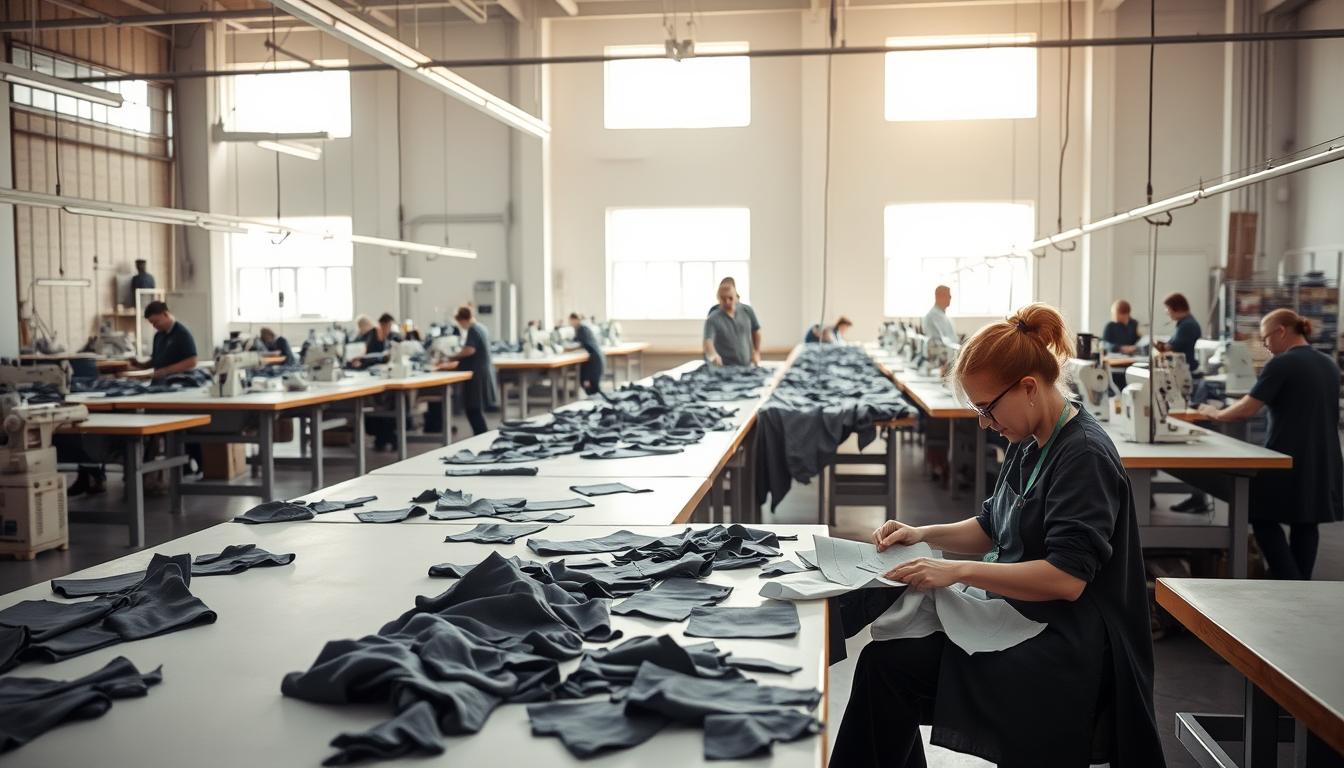Zero Waste in Uniform Production: Is It Possible?
The production of uniforms is a significant contributor to environmental degradation, with the manufacturing process generating substantial waste. As the world shifts towards more sustainable practices, the question arises: can uniform production achieve zero waste? Uniforms are an integral part of various organizations, from schools to corporate entities, and their production involves considerable resources.

The environmental impact of traditional uniform manufacturing is substantial, with fabric waste, energy consumption, and water pollution being major concerns. However, manufacturers are now adopting innovative strategies to make uniform production more sustainable. By exploring these new approaches, we can determine the feasibility of achieving zero waste in uniform production.
Key Takeaways
- The uniform production industry is shifting towards sustainability.
- Achieving zero waste in uniform production is a challenging but attainable goal.
- Innovative manufacturing strategies can significantly reduce environmental impact.
- Sustainable practices in uniform production can benefit both the environment and businesses.
- The future of uniform production lies in adopting eco-friendly practices.
The Environmental Impact of Traditional Uniform Manufacturing
The environmental footprint of traditional uniform manufacturing is a pressing concern that warrants immediate attention. The garment industry, which includes uniform production, is one of the largest polluters worldwide.
“The textile industry is a significant contributor to environmental degradation, with uniform manufacturing being a substantial part of this problem,” as noted by industry experts. The production process generates massive amounts of waste, consumes considerable resources, and results in pollution.
Current Waste Statistics in the Global Textile Industry
The global textile industry produces an estimated 12% of global greenhouse gas emissions. Uniform manufacturing contributes to this statistic, with the average production process generating significant fabric waste. Reducing waste in garment manufacturing is crucial to mitigating this environmental impact.

India’s Uniform Production Footprint
India plays a significant role in global uniform production. The country’s garment manufacturing sector is a substantial contributor to its economy, but it also has a considerable environmental footprint due to the large-scale production of uniforms.
Hidden Environmental Costs Beyond Fabric Waste
Beyond fabric waste, uniform manufacturing has other environmental costs, including energy consumption, water usage, and chemical pollution from dyeing and finishing processes. These hidden costs underscore the need for more sustainable practices in uniform production.
Implementing sustainable manufacturing practices can significantly reduce the environmental impact of uniform production. This includes adopting waste reduction strategies and using eco-friendly materials.
Understanding Zero Waste in Uniform Production
The concept of zero waste is revolutionizing the uniform production industry. As manufacturers increasingly adopt sustainable practices, understanding the principles of zero waste becomes crucial. Zero waste in uniform production involves a holistic approach to minimizing waste throughout the production lifecycle.
Defining the Zero Waste Approach in Garment Manufacturing
The zero waste approach in garment manufacturing involves designing out waste from the production process. This means using materials efficiently, optimizing patterns to minimize offcuts, and ensuring that any waste generated is either recyclable or biodegradable. By adopting this approach, uniform manufacturers can significantly reduce their environmental footprint. Efficient material usage is key to achieving zero waste.

The Circular Economy Model for Uniform Lifecycles
The circular economy model offers a framework for achieving zero waste by promoting the reuse and recycling of materials throughout the product lifecycle. This model encourages manufacturers to design products that can be recycled, reused, or biodegradable, thus reducing waste and the continuous consumption of new resources. Implementing a circular economy model can help uniform manufacturers reduce waste and improve sustainability.
Measuring Success: Zero Waste Metrics and Standards
To measure the success of zero waste initiatives, manufacturers need to adopt clear metrics and standards. These may include tracking waste reduction, material efficiency, and overall sustainability. By establishing these metrics, uniform manufacturers can monitor their progress, identify areas for improvement, and ensure that their zero waste practices are effective. Regular audits and assessments are essential for maintaining high standards.
By understanding and implementing zero waste practices, uniform manufacturers can contribute to a more sustainable future. The combination of efficient material usage, a circular economy model, and robust metrics for measuring success will be crucial in achieving this goal.
The Business Case for Sustainable Uniform Production
The business case for sustainable uniform production is compelling, with benefits extending beyond environmental conservation. Companies are increasingly recognizing the value of adopting eco-friendly practices in their production processes.
By embracing sustainability, uniform manufacturers can not only reduce their environmental impact but also improve their bottom line. This is achieved through various means, including waste reduction and improved material efficiency.
Long-term Cost Benefits of Waste Reduction Strategies
Implementing waste reduction strategies in uniform production can lead to significant long-term cost savings. By optimizing fabric usage and minimizing waste, manufacturers can lower their material costs and reduce waste disposal expenses.
- Reduced material costs through efficient fabric usage
- Lower waste disposal costs
- Potential revenue from recycling or upcycling production waste
Meeting Growing Corporate Demand for Ethical Uniforms
There is a growing trend among corporations to demand more ethical and sustainable uniforms. By adopting sustainable production practices, uniform manufacturers can meet this demand and differentiate themselves in a competitive market.
Key benefits include:
- Increased customer loyalty among environmentally conscious corporations
- Access to new market opportunities in the sustainable uniform segment
- Enhanced brand reputation through commitment to sustainability
Government Incentives for Sustainable Manufacturing in India
The Indian government offers various incentives for manufacturers adopting sustainable practices. These incentives can help offset the initial costs of implementing sustainable production methods.
By taking advantage of these incentives, uniform manufacturers in India can accelerate their transition to more sustainable production processes, improving their competitiveness in both local and international markets.
Sustainable Fabric Sourcing for Uniform Manufacturers
Eco-conscious clothing production begins with sustainable fabric sourcing, a crucial step for uniform manufacturers. As the textile industry continues to evolve, the importance of environmentally friendly materials cannot be overstated. Uniform manufacturers are now faced with the challenge of sourcing fabrics that not only meet quality standards but also align with sustainability goals.
Eco-Friendly Fabric Options Available in the Indian Market
The Indian market offers a diverse range of eco-friendly fabric options for uniform manufacturers. These include natural fibers, recycled materials, and regenerated textiles. By choosing these materials, manufacturers can significantly reduce their environmental footprint.
Natural Fiber Innovations
Natural fibers such as organic cotton, hemp, and bamboo are gaining popularity in the uniform manufacturing sector. These fibers are biodegradable, require less water and pesticides, and offer excellent durability. Innovations in natural fiber production have made them more accessible and affordable for manufacturers.
Recycled and Regenerated Materials
Recycled and regenerated materials are another viable option for sustainable fabric sourcing. These materials are made from post-consumer waste or pre-consumer waste, reducing the need for virgin raw materials. They offer a closed-loop production system, minimizing waste and the environmental impact of uniform production.
Evaluating Suppliers for Sustainability Credentials
When sourcing sustainable fabrics, uniform manufacturers must evaluate their suppliers based on their sustainability credentials. This involves looking for certifications such as GOTS (Global Organic Textile Standard) or Oeko-Tex, which ensure that the materials meet certain environmental and social standards.
Building Sustainable Supply Chain Partnerships
Building long-term partnerships with suppliers who share a commitment to sustainability is crucial for uniform manufacturers. By collaborating with suppliers, manufacturers can ensure a consistent supply of eco-friendly materials, drive innovation in sustainable fabric production, and reduce the environmental impact of their supply chain.
Zero Waste Pattern Cutting and Design Techniques
To achieve zero waste in uniform production, manufacturers must adopt innovative pattern cutting and design techniques. Traditional pattern making often results in significant fabric offcuts, but new methods can minimize this waste.
Traditional vs. Zero Waste Pattern Making
Traditional pattern making involves creating patterns based on standard sizes, often leading to considerable fabric waste. In contrast, zero waste pattern making focuses on designing patterns that maximize fabric use, minimizing offcuts. This approach requires a fundamental shift in how designers work, prioritizing fabric efficiency alongside aesthetic considerations.
Innovative Design Methods for Minimizing Offcuts
Several innovative design methods can help minimize offcuts in uniform production. Two notable approaches are jigsaw pattern cutting and modular design.
Jigsaw Pattern Cutting
Jigsaw pattern cutting involves creating interlocking patterns that fit together like a puzzle, significantly reducing fabric waste. This technique requires careful planning and design but can lead to substantial reductions in offcuts.
Modular Design Approaches
Modular design involves breaking down uniform components into modular parts that can be rearranged or repurposed, reducing the need for new fabric. This approach encourages creativity in design and can lead to innovative uniform solutions.
Technology Solutions for Pattern Optimization
Technology plays a crucial role in optimizing patterns for zero waste production. Digital pattern making software can analyze and adjust patterns to minimize waste, making it easier for manufacturers to adopt zero waste practices. These tools can simulate different fabric layouts, predict potential waste areas, and suggest adjustments to maximize fabric use.
By embracing zero waste pattern cutting and design techniques, uniform manufacturers can significantly reduce their environmental impact while maintaining high-quality products. As the industry continues to evolve, the integration of technology and innovative design methods will be key to achieving zero waste goals.
Low-Impact Dyeing and Finishing Processes
The environmental impact of uniform manufacturing can be significantly reduced by adopting sustainable dyeing and finishing practices. Dyeing and finishing are critical stages in uniform production that have traditionally been associated with high water usage and chemical consumption.
Water-Saving Dyeing Technologies Accessible in India
India, being a significant player in the textile industry, has been adopting various water-saving dyeing technologies. These innovations are crucial for reducing the environmental footprint of uniform production.
Digital Printing Alternatives
Digital printing is a water-saving alternative that allows for precise dye application, reducing waste and enabling complex designs without significant environmental impact.
Waterless Dyeing Innovations
Waterless dyeing technologies are emerging as a revolutionary solution, eliminating the need for water in the dyeing process. This not only saves water but also reduces energy consumption.
Non-Toxic Finishing Alternatives for Durable Uniforms
Finishing processes can be made more sustainable by using non-toxic alternatives that ensure durability without compromising on safety or environmental sustainability. These alternatives are crucial for producing uniforms that are both durable and safe for wearers.
Waste Management Strategies in Production Facilities
The implementation of robust waste management strategies is a key step towards zero waste in uniform production. Effective waste management not only reduces the environmental impact of manufacturing processes but also contributes to cost savings and improved brand reputation.
Implementing Effective Material Recovery Systems
Material recovery systems are crucial for recycling and reusing waste materials generated during uniform production. By implementing these systems, manufacturers can significantly reduce the amount of waste sent to landfills. Efficient material recovery involves sorting and processing waste materials to ensure they can be reused or recycled. This not only reduces waste but also conserves resources.
Upcycling Production Scraps into Value-Added Products
Upcycling production scraps into value-added products is an innovative way to reduce waste and create new revenue streams. By transforming waste materials into desirable products such as bags, accessories, or even new clothing lines, manufacturers can offset the costs associated with waste disposal. This approach also enhances brand image by demonstrating a commitment to sustainability.
Collaborating with Waste Management Partners
Collaborating with waste management partners can provide uniform manufacturers with the expertise and resources needed to manage waste sustainably. These partnerships can help identify the most effective waste reduction strategies and ensure compliance with environmental regulations. By working together, manufacturers can achieve their sustainability goals more effectively.
By adopting these waste management strategies, uniform production facilities can significantly reduce their environmental footprint. Implementing material recovery systems, upcycling production scraps, and collaborating with waste management partners are all crucial steps towards achieving zero waste in uniform production.
Case Studies: Successful Zero Waste Uniform Manufacturers in India
Several Indian uniform manufacturers are pioneering the zero waste movement, setting new standards for sustainability in the industry. These companies are demonstrating that it’s possible to produce high-quality uniforms while minimizing environmental impact.
Small-Scale Success Stories from Indian Entrepreneurs
Small-scale manufacturers are making significant strides in adopting zero waste practices. For instance, a Mumbai-based company has implemented a zero waste pattern cutting system, reducing fabric waste by up to 20%. This not only helps the environment but also improves their bottom line.
Another example is a Chennai-based startup that has developed an innovative upcycling program for production scraps, turning them into value-added products like bags and accessories.
Large Manufacturers Leading the Sustainability Movement
Large uniform manufacturers in India are also embracing sustainability. A leading manufacturer has adopted a circular economy model, designing uniforms that are recyclable and reusable. They’ve also implemented a take-back program for used uniforms, ensuring responsible disposal.
Another major player has invested in water-saving dyeing technologies, significantly reducing their water footprint and chemical usage.
International Collaborations Bringing Zero Waste Expertise to India
International collaborations are playing a crucial role in bringing zero waste expertise to India. A European fashion brand has partnered with an Indian manufacturer to introduce advanced zero waste design techniques, enhancing their production processes.
These collaborations are not only improving sustainability but also enhancing the competitiveness of Indian manufacturers in the global market.
By adopting best practices for sustainable uniform production, Indian manufacturers are setting a new benchmark for the industry. As the demand for eco-friendly uniforms continues to grow, these companies are well-positioned to lead the way.
Overcoming Implementation Challenges for Indian Manufacturers
Despite the benefits, Indian manufacturers encounter significant hurdles in implementing zero waste uniform production. The transition to sustainable practices requires overcoming several challenges that can impact the feasibility and success of zero waste initiatives.
Addressing Initial Investment Concerns
One of the primary challenges faced by Indian manufacturers is the initial investment required to adopt zero waste practices. This includes costs associated with new equipment, training, and process modifications. However, these costs can be offset by long-term savings through reduced waste and improved efficiency. Manufacturers can explore government incentives and grants that support sustainable manufacturing practices.
Training Staff for Sustainable Production Methods
Training staff is crucial for the successful implementation of zero waste practices. Indian manufacturers must invest in educating their workforce on new techniques and technologies. This not only enhances their skills but also fosters a culture of sustainability within the organization. Collaborating with training institutions and industry experts can facilitate this process.
Balancing Traditional Craftsmanship with Modern Zero Waste Techniques
India’s rich textile heritage is characterized by traditional craftsmanship, which can be integrated with modern zero waste techniques. Manufacturers can adopt innovative design methods that respect traditional practices while minimizing waste. This blend of old and new not only preserves cultural heritage but also appeals to consumers looking for sustainable, culturally rich products.
By addressing these challenges, Indian manufacturers can successfully implement zero waste practices, contributing to a more sustainable textile industry. The key is to balance tradition with innovation, ensuring that the transition to zero waste production is both economically viable and environmentally friendly.
Conclusion: The Future of Zero Waste Uniform Production in India
The future of zero waste uniform production in India is promising, driven by the growing demand for sustainable practices in the textile industry. As uniform manufacturers adopt innovative design techniques, sustainable fabric sourcing, and effective waste management strategies, the industry is poised to make a significant positive impact on the environment.
By embracing the zero waste approach, Indian uniform manufacturers can not only reduce their environmental footprint but also enhance their brand reputation and comply with increasingly stringent environmental regulations. The integration of circular economy models and sustainable supply chain partnerships will be crucial in achieving this goal.
As the industry moves forward, collaboration between manufacturers, suppliers, and waste management partners will be essential in driving the adoption of zero waste practices. With the right strategies in place, India can become a leader in sustainable uniform production, setting a new standard for the global textile industry.
FAQ
What is zero waste uniform production, and is it achievable in India?
Zero waste uniform production refers to the design and production of uniforms with minimal to no waste generation. While challenging, it is achievable in India with the adoption of sustainable practices, innovative design techniques, and effective waste management strategies.
How can uniform manufacturers reduce textile waste?
Uniform manufacturers can reduce textile waste by adopting zero waste design techniques, using sustainable fabrics, implementing material recovery systems, and upcycling production scraps into value-added products.
What are the benefits of sustainable uniform production for businesses?
Sustainable uniform production offers several benefits, including long-term cost savings, enhanced brand reputation, and compliance with growing corporate demand for ethical and sustainable products. Government incentives in India further support the transition to eco-friendly production methods.
What eco-friendly fabric options are available for uniform production in India?
The Indian market offers a range of eco-friendly fabric options, including natural fibers, recycled materials, and regenerated materials. Uniform manufacturers can evaluate suppliers based on their sustainability credentials to source the most environmentally friendly fabrics.
How can technology support zero waste uniform production?
Technology, such as digital pattern making software, can optimize patterns to minimize waste. Additionally, innovations like digital printing alternatives and waterless dyeing technologies can reduce the environmental impact of dyeing and finishing processes.
What are some successful strategies for waste management in uniform production facilities?
Effective waste management strategies include implementing material recovery systems, upcycling production scraps, and collaborating with waste management partners. These approaches can help minimize waste and create new revenue streams.
Are there any government incentives for sustainable manufacturing in India?
Yes, the Indian government offers incentives for sustainable manufacturing, supporting businesses that adopt eco-friendly production methods and reduce their environmental footprint.
How can uniform manufacturers balance traditional craftsmanship with modern zero waste techniques?
By integrating traditional craftsmanship with modern zero waste techniques, uniform manufacturers can create sustainable, high-quality uniforms that meet both environmental and aesthetic standards.

